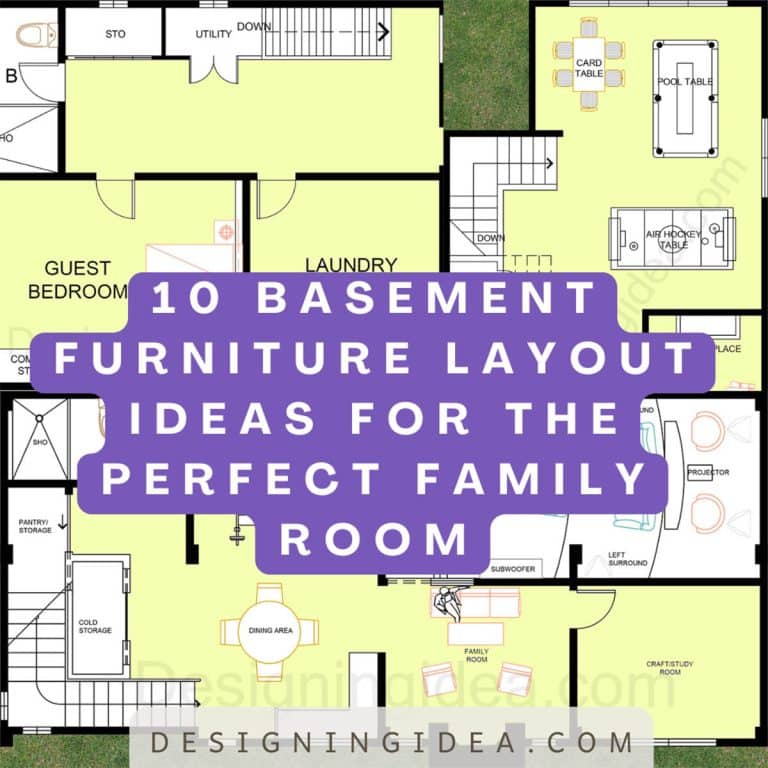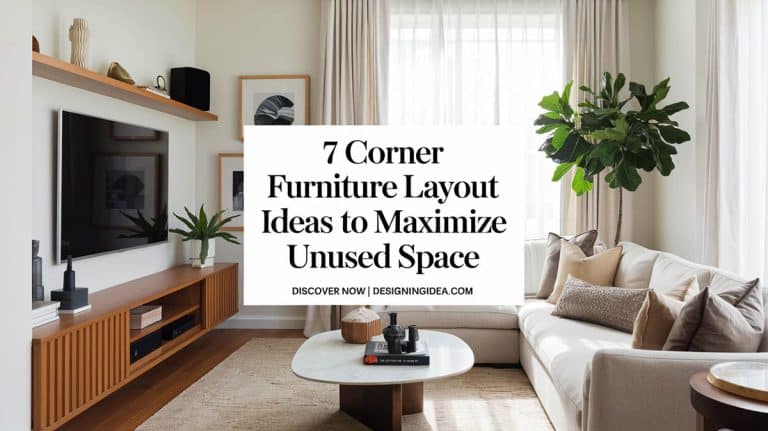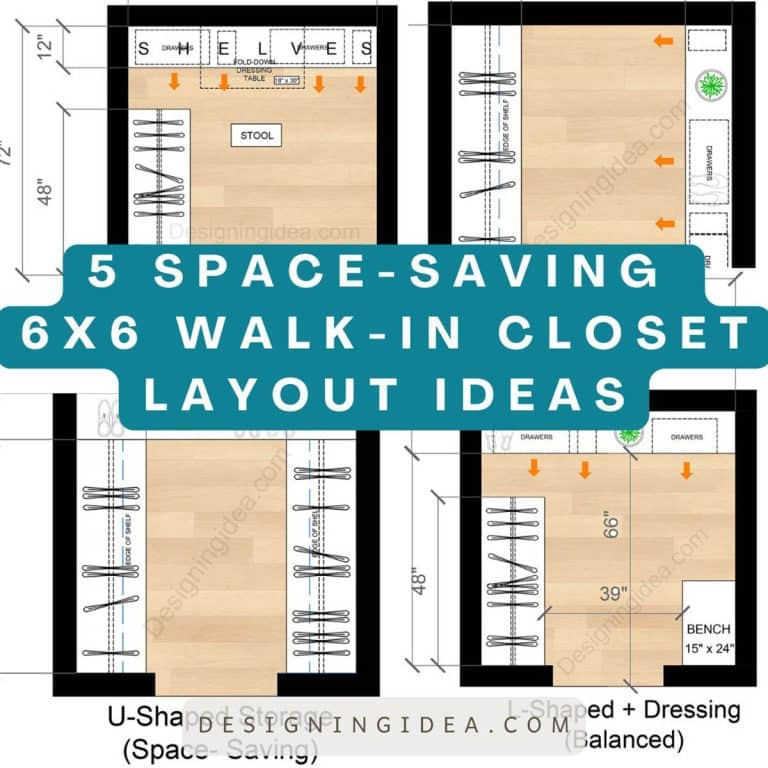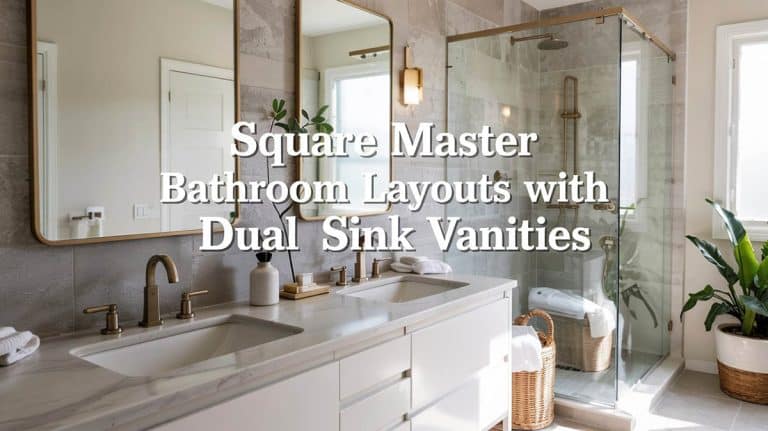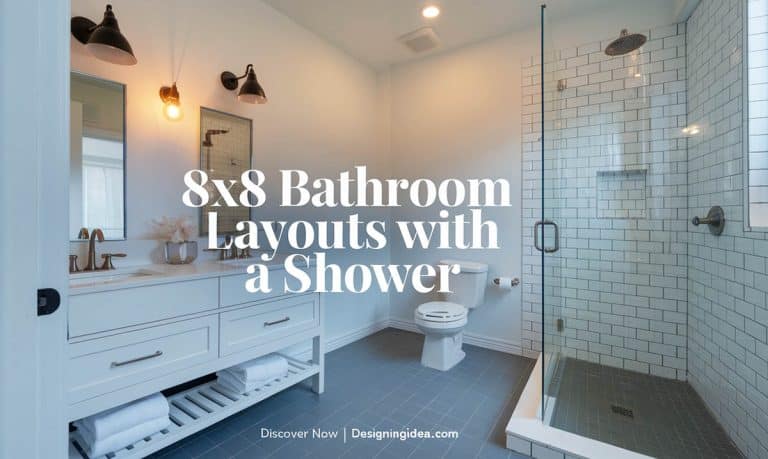6×12 Walk-in Closet Layouts For An Efficient And Stylish Design
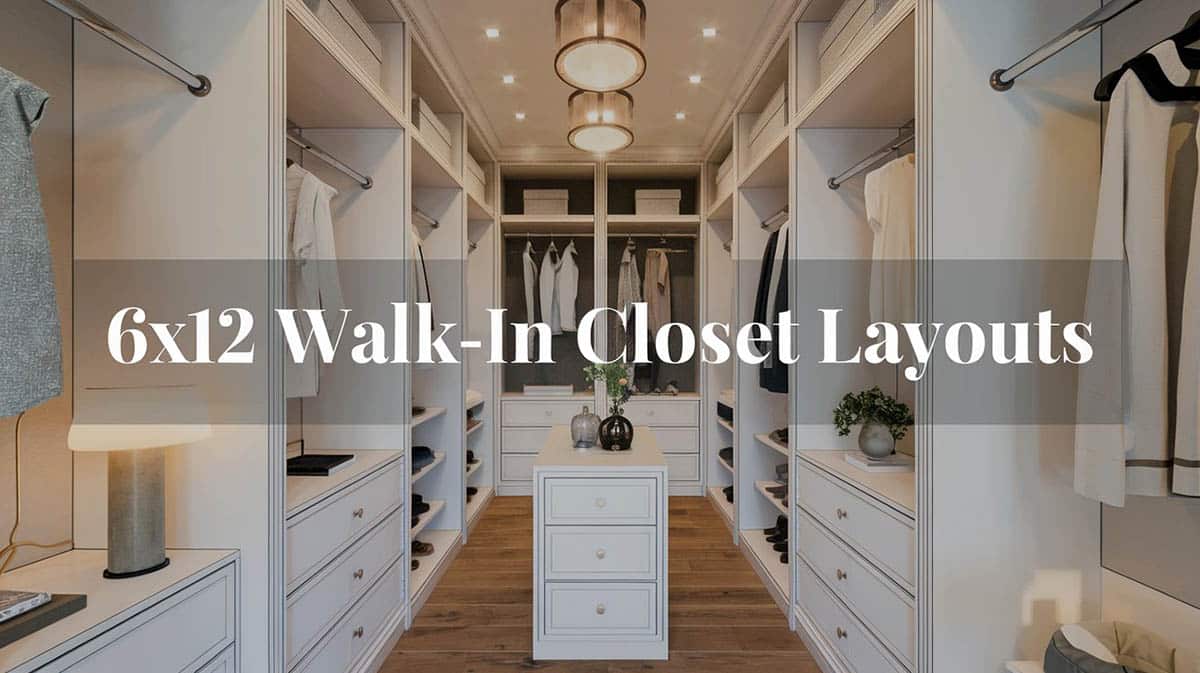
Designing for a 6×12 closet can feel cramped if you’re not careful. But when properly laid out, it can feel like a mini boutique with plenty of room for all of your needs. Below, you’ll see ready-to-use floor plans (galley, L‑shape, U‑shape, vanity, and console options) with the storage sizes, aisle clearances, and elegant add-on options, so you’ll know what really fits. Let’s turn your 6×12 walk-in closet into the hardest‑working (and best‑looking) room in your home.
Galley Style Closet with Middle Walkway Layout
This floor plan pairs a wide 44″ center aisle that offers plenty of room to move with two 14″ deep, full‑length storage runs on either side that maximize your linear hanging and shelving space.
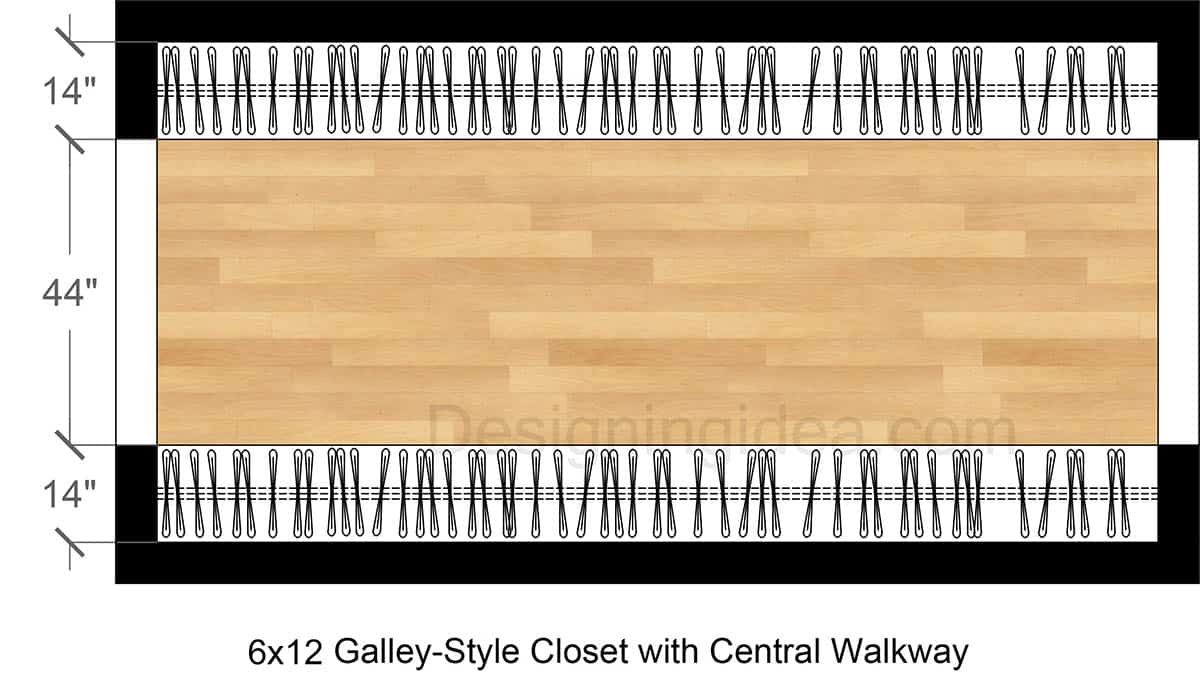
Floor Plan Details: This layout uses both 12‑ft long walls for clothing storage and leaves a wide, 44″ aisle running down the middle. At just 6 ft wide, the design is all about efficiency with shallow 14″ deep clothing racks on each side and overhead shelves for extra storage space for seasonal or seldom-used items. The walkway is large enough that two people can pass comfortably. It’s a symmetrical walk-in closet that works well for a his-and-hers setup and is perfect for those wanting high-capacity double hanging.
Dimensions:
- Room size: 6′ × 12′ (72″ × 144″)
- Storage depth (both sides): 14″ each
- Aisle width: 44″
- Suggested double‑hang rod heights (optional): 40″ and 80″ off the floor
- Recommended drawer pull‑out clearance: keep drawer depths 20″ so you still retain 24″ of pass‑through space when open
Design Tips:
- Prioritize double hanging. With its 6′ width, stacking two clothes rods per side allows for the biggest capacity gain. Reserve a short section at one end for a 24″‑deep long‑hang if you have bulky items.
- Use towers at the ends. Put shoe towers, drawer cabinets, or a tilt‑out hamper at either (or both) 12′ ends so they are easy to access. This is useful for a closet to bathroom design.
- Light the runs, not just the ceiling. Adding LED strips under the shelves eliminates extra shadows in a long and narrow galley.
- Mirror on one wall. A full‑height mirror on one wall creates a dressing area.
- Add a sliding door. Adding a pocket or sliding door helps keep the aisle unobstructed by a swinging door.
- Label and zone. With two identical sides, assign categories (or his/hers) for each wall so everything is quick and easy to find.
- Ventilation & dust control. Add cabinet fronts or glass doors to any cabinet sections for delicate garments.
Why it Works: An efficient layout with an abundance of storage options that works well for couples who prefer clear organization and access.
L-Shaped Closet with Compact Dressing Area Floor Plan
This long, L-shaped layout works by keeping clothing racks stacked along two walls, with a defined dressing corner for an organized, open, and easy feel.
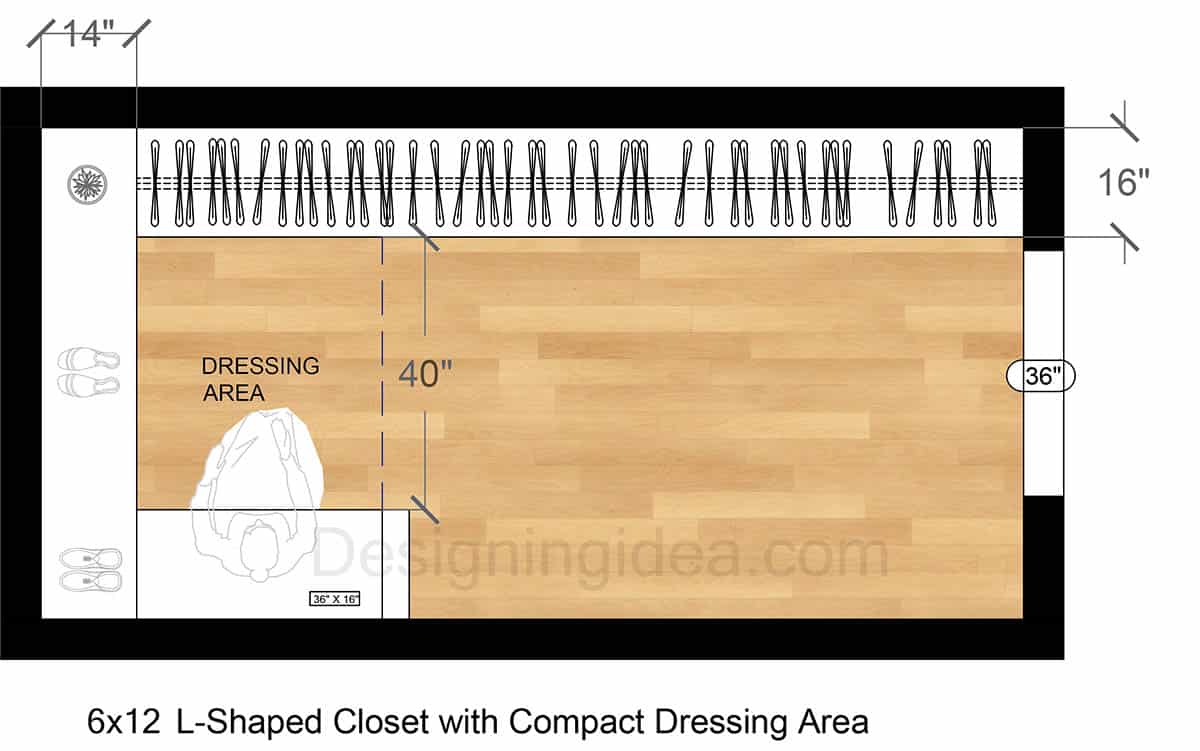
Floor Plan Details: This design concentrates nearly all hanging and storage on a long 12‑ft wall with 16″ deep racks, and a short 14″‑deep leg at the end to form an L. This arrangement frees up the opposite side for a compact dressing area with a 36″×16″ bench. This allows for a comfortable 40″ walkway through the space and room to try on outfits without feeling constrained. You get strong linear hanging capacity, a place to sit and change, and an easy room to navigate.
Dimensions:
- Room size: 6′ × 12′ (72″ × 144″)
- Primary storage depth: 16″ (along long wall)
- Return leg depth: 14″ (for shoes or accessories)
- Clear walkway: 40″
- Door width: 36″
- Bench: 36″ (W) × 16″ (D)
Design Tips:
- Zone the “L.” Use the 14″ leg for shoe shelves, drawer stack, or handbags, keeping bulkier items on the higher shelves.
- Double‑hang the long wall. Two rods (approx. 40″ & 80″) will increase storage capacity .
- Anchor the dressing corner. Add a full‑height mirror by the bench to enhance the get‑ready zone.
- Light the bench. A focused sconce or recessed downlights above the dressing area will enhance the changing space.
- Low-profile doors. If possible, use an outswing or pocket door to avoid encroaching on your closet space.
- Slim drawers. Keep drawer depths at 18 to 20″ to avoid interfering with the aisle when opened.
- Hooks & valet rod. Place hooks near the bench for setting out outfits for the next day.
- Don’t forget the bench. Add a 36″ x 16″ bench with under seat storage for additional linens or pillows.
Why it Works: For those wanting a dedicated dressing area, without feeling cramped while setting aside space for shoes and clothes storage.
U-Shaped Closet Layout That Maximizes Storage Space
With hanging rods on three sides and some shallow cabinetry for shoes, this U‑shape design maximizes linear storage while providing a large center aisle for easy usability.
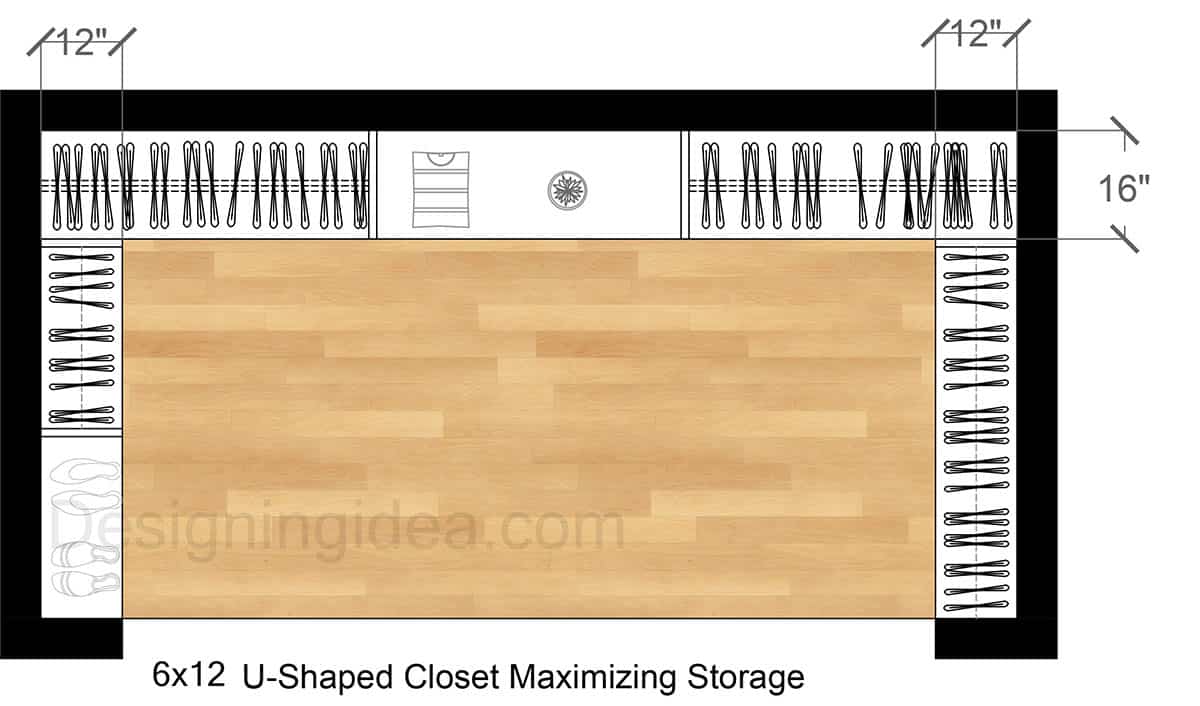
Floor Plan Details: A U-shaped layout is ideal for those who want an easy-to-access space with three walls of storage, so you can squeeze the most linear footage out of a tight 6‑ft width. This works well for a master bedroom with two large sliders or a curtain separating the closet from the room. The two side legs use shallower 12″ rods for double hanging, while the back wall switches to a deeper 16″ run with a center shelf section for drawers or shoe storage. The combination preserves a comfortable central floor area (40″) while allowing you to easily browse for the clothing items you want.
Dimensions:
- Room size: 6′ × 12′ (72″ × 144″)
- Side legs depth: 16″ each
- Back wall depth: 12″
- Approx. aisle: 50″ +
- Typical double‑hang rod heights (suggested): 40″ & 80″
- Ideal drawer depth: 16″ on the back so the aisle stays usable when open
Design Tips:
- Use depth strategically. Keep double‑hang and bulkier items on the 16″ wall while reserving the 12″ side walls for shoes and accessories.
- Get the most out of the corners. Add shoe towers or corner units to both inside corners to avoid potential dead zones.
- Mirror the back. Add a full‑height mirror on the back wall for dressing and to visually widen the room.
- Light under the shelving. Add LED strips under shelves on all three runs to enhance the look and feel.
- Door choice. Opt for a sliding door to keep the area closed off when not in use.
Why it Works: Ideal for those with an extensive wardrobe who want to optimize for usability without sacrificing comfort.
Walk-In Closet with Floating Vanity Floor Plan
With a slim, floating vanity in one corner, the room gets a true getting‑ready station without sacrificing the walkway or clothing storage.
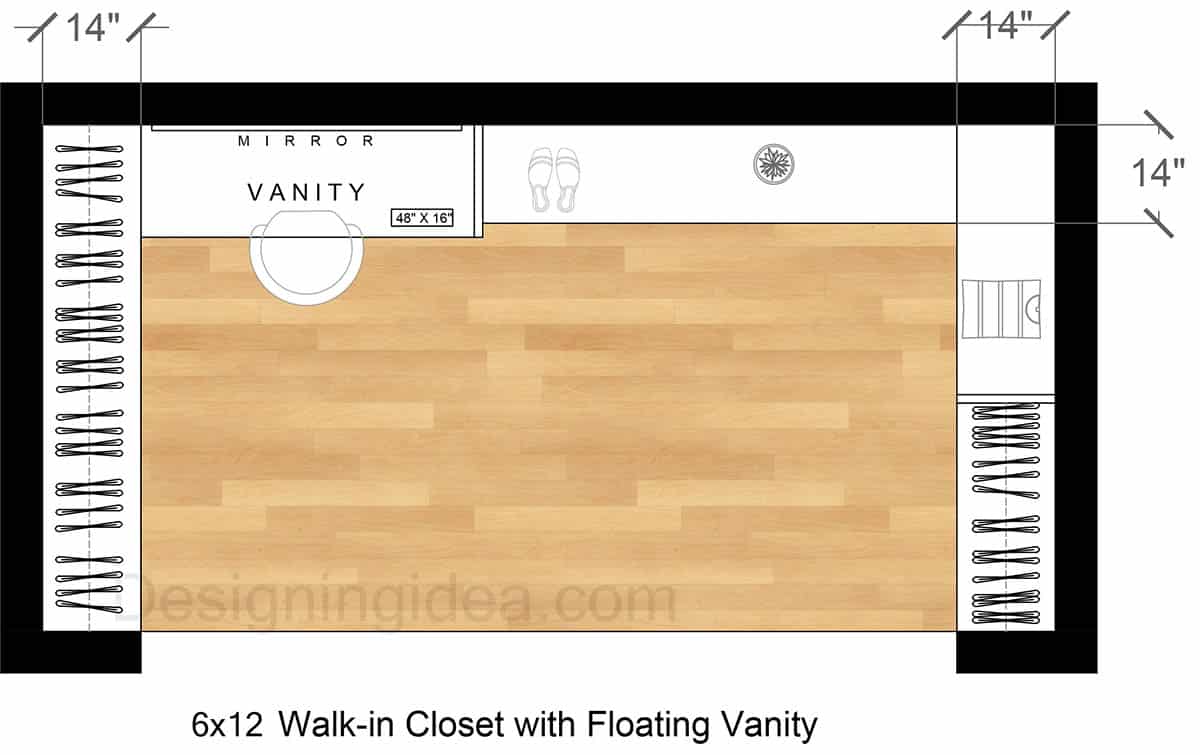
Floor Plan Details: I love a walk-in closet with a vanity, as it carves out a little space for all of my makeup and essentials and keeps them out of sight from the main bedroom. This closet layout uses efficient 14″‑deep hanging runs on three sides with a 48″ × 16″ floating vanity with mirror in one corner. The floating vanity with a mirror and stool creates a grooming zone that’s perfect for applying makeup or doing your hair. Next to the vanity is a 14″ deep L-shaped rack that hugs the opposite side and can be used for folded clothes, or shoes. By keeping cabinetry and clothes rods shallow, you preserve a generous aisle for dressing.
Dimensions:
- Room size: 6′ × 12′ (72″ × 144″)
- Storage depth (both ends/side runs): 14″
- Vanity size: 48″ (W) × 16″ (D), floating
- Approx. clear aisle: 58″
- Typical double‑hang rod heights (optional): 40″ & 80″
Design Tips:
- Light it like a bathroom. Add vertical light sconces or a backlit mirror at eye level for shadow‑free grooming.
- Float the vanity to feel bigger. Keep the vanity off the floor can let you tuck a slim stool or ottoman underneath.
- Power + ventilation. Plan outlets inside the vanity area for hair tools and ensure an adequate ventilation fan if you’ll be using hot tools regularly.
- Drawer discipline. Use narrow (-14 deep) drawers to keep the aisle free.
- Allocate a hamper tower. Add a tilt‑out hamper or pull‑outs for easy laundry collection.
- Mirror placement. Supplement the vanity mirror with a full‑height mirror on the opposite corner.
- Accent shelving. The long wall next to the vanity is ideal for display shelves (bags, hats, fragrance).
Why it Works: By balancing functional storage with a vanity space, you can keep all of the makeup and grooming accessories out of the main bedroom.
Kids Closet with Narrow Console Design
By pairing super‑shallow 12″ runs with a movable 36″ × 16″ console, this design delivers a boutique feel and serious flexibility while preserving an extra‑roomy 48″ aisle in a compact 6×12 footprint.
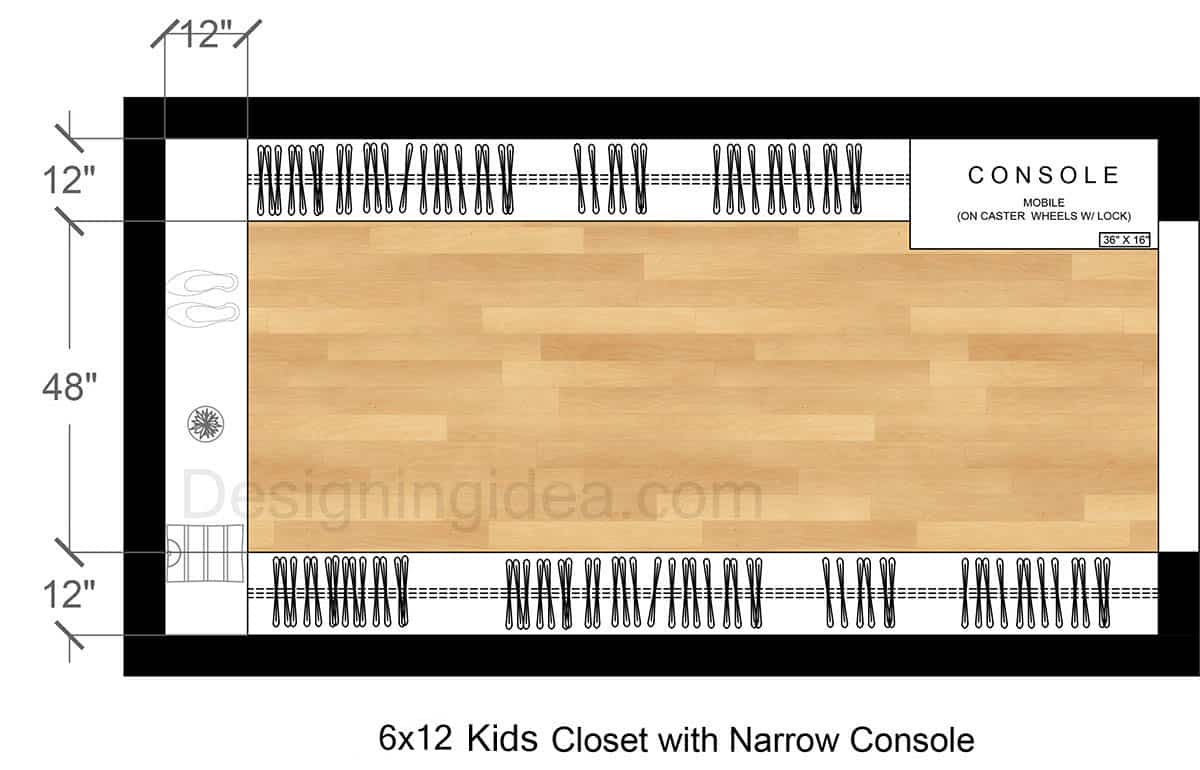
Floor Plan Details: This plan is ideal for a shared child’s bedroom, both long walls with ultra‑slim 12″ deep hangers that are a perfect size for children, freeing up a 48″ central aisle that is easy to move through. Instead of a fixed island which won’t fit in a 6‑ft width, you get a mobile 36″ × 16″ narrow console on locking casters which can be used for clothes, shoes, toys, or even books if needed. The back wall is set up with shelving that’s useful for displaying shoes or folded clothing, so they are easy to find when you’re in a rush to get to school or activities.
Dimensions:
- Room size: 6′ × 12′ (72″ × 144″)
- Storage depth (both long walls): 12″ (kids’ size)
- Mobile console: 36″ (W) × 16″ (D) on locking casters
- Suggested double‑hang rod heights: 40″ & 80″ (use slim/offset hardware to work with 12″ depth)
Design Tips:
- Go shallow, go vertical. Use 12″ depth for shelves, shoes, handbags, and forward‑facing hanging rods to keep everything in its place.
- Console = flexible island storage. Add extra clothing items to the console storage or dedicate it as a LEGO storage or other useful function.
- Low‑profile hardware. Slim hangers and offset/centered rods prevent sleeves from hitting the wall for a 12″ depth.
- Mirror the short wall. A full‑height mirror makes outfit checks easy to do.
- Categorize by wall. Dedicate one wall to double‑hang and folded knits, the other to shoes.
- Add an interactive wall. If you want to keep items like bulletin boards, chalkboards or whiteboard panels out of the main bedroom, setting up a dedicated wall here works great.
Why it Works: Offers a kids-focused storage area while preserving comfortable movement with a movable console to help keep clutter contained.
For a similar gallery, check out our 5ft x 10ft closet designs.

